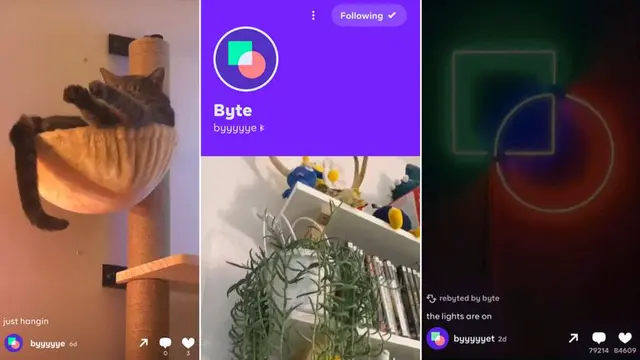The early days of a new social network offer a fine opportunity to witness the naked motivations of users, as the relaunch of Vine shows.
Over the weekend Vine's co-creator Dom Hofmann launched Byte, which hosts six-second looping videos just like Vine did before its acquisition and eventual, much lamented, shut down by Twitter.
In just a few days Byte has risen to the top of the App Store's chart for social networking apps, and has hundreds of thousands of downloads on Android as well.
The influx of users chasing fame and flooding the comment section of videos with requests for mutual follows has inspired a few videos quipping about "TikTok rejects", but Byte has some key differentiating qualities.
Unlike rival platforms, Byte plans to quickly launch a partner programme so that content creators can collect a share of the revenues which their content is producing.
TikTok, in comparison, only enables users to earn money once they have been offered a sponsorship - often only done from brands towards users with more than a million followers.
The six-second video is a good sell in the attention economy. It doesn't take up too much of its audience's time and even if the video is bad, the brevity of the clip means a palette cleanser isn't too far away.
It does require creativity and talent to produce a clever six-second video, too. In that sense, the format is a meritocratic contribution to the attention economy. It is streamlined to be audience-friendly.
But the concerning impact of social video platforms such as Vine, Byte or Tik-Tok isn't on their audiences, it's on the content creators themselves.
Mr Hofmann acknowledged that the company is "aware of the issues with comment spam" as the majority of content on the platform's comment section seems to be requests of mutual follows.
Unlike Facebook, Instagram, Twitter and YouTube - but similar to TikTok - Byte doesn't yet offer users a method to link out of the platform, which will limit investments from media organisations seeking to expand their reach.
Whether the platform's own revenue-sharing programme could see mainstream content producers flock there - as they did with YouTube - is yet to be seen.
It isn't something that happened with Vine, which ultimately became abandoned due to a lack of quality content, but the creative constraints and opportunities of the six-second video format have plenty of room for ingenuity without resources.
Whether or not that can be turned into something as fun to take part in and watch as TikTok's lip-syncing and dance videos isn't clear - but it's early days yet.
 简体中文
简体中文

